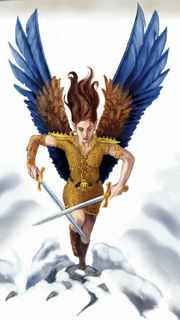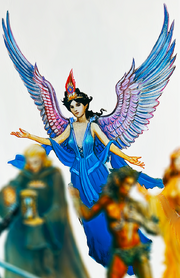The avariel (aril-tel-quessir, or "winged folk", in Elven) were among the first of the elf races to migrate to Faerûn.[5] However, conflict with dragons almost wiped them out before the First Flowering and while they survived since that time, they were considered by most to be myths or legends.[6][1]
Description[]
Avariel were more delicate than their earth-bound cousins, with hollow bones to aid their flight. They had pale skin, often porcelain white. An avariel's wings were usually white, but could be black, brown, or speckled. Their eyes were slightly larger than normal and ranged in color from brilliant blues to green or purple. Their hair color was normally a silver-white or black.[6]
Society[]
Avariel society was split into two groups that coexisted together, labeled "warlike" and "peaceful". Young avariel spent time immersed in both cultures (this could last over a decade), so that no matter what sect they came from, they had a deep understanding and respect of how the other half lived.[3]
Warlike Avariel[]

A female avariel dressed in golden chainmail and gliding into battle.
Avariel warriors were geared towards war and power, answering to war chiefs who governed avariel society equally with the religious leaders. They lived by a complex code of honor and spent their lives defending their race. In combat, these avariel showed no mercy, often using ranged attacks from above and believing that others should know better than to create an enemy of a superior foe such as themselves. They also viewed surrender to be dishonorable (for both themselves as well as their enemies), holding the idea that when a warrior drew blood, it was a promise to honor them with their combat skill, and slaying them was fulfilling that promise. To leave a defeated foe alive was to humiliate them.[3]
Peaceful Avariel[]
The other side of avariel society included scholars, philosophers, and artists. Intellectuals who believed in solving problems through reason and diplomacy, these avariels spent much time researching magic and history, contemplating religion, worshiping Aerdrie Faenya, and producing art for the sheer joy of creation.[3]
Settlements[]
At one time, the center of avariel worship of Aerdrie was in the Aerie, a temple-city located in the Star Mounts within the High Forest. The ruins of the Aerie were said to be inhabited either by the red dragon Imvaernarhro or the green dragon Elaacrimalicros. Some legends stated that survivors from the Aerie could still be found in lands west of Faerûn.[7]
The last known shelter for the avariels was the Aerie of the Snow Eagles, located on the eastern edge of the Great Glacier.[6]
Languages[]
In addition to speaking elvish,[3] the avariels had their own unique form of sign language based around aerial movement. Involving things such as flaps, stalls, and wind dips. It was a less subtle sign language than those of non-flying races, having been developed primarily for communication during flight.[8]
Religion[]
Most revered Aerdrie Faenya, the elven goddess of air, sky, and weather, and they acknowledged the other deities of the Seldarine to a minor extent. Aerdrie Faenya was held above all as she was considered to be the one that saved them from extinction and that she intervened in their favor.[9]
Relationships[]
Avariels had good relationships with other good-aligned races who lived in the sky. They had strong ties with the aarakocra, as they shared the same patron deity and had the same respect for nature. For a very long time, they nourished respectful and admiring bonds with giant eagles.[10]
Maleficent dragons considered avariels as enemies and their magic as a threat.[10]
History[]

An avariel priestess of Aerdrie Faenya.
They were one of the most ancient elven races, having arrived very early in Faerûn's history. Unfortunately, they were quickly confronted with the cruel dragons who ruled the land.[6] They almost all died before the First Flowering,[6] and a vast percentage of the race died when the avariel made a valiant and successful effort to defend the Dracorage mythal from an allied force of dragons.[11] In response, the remaining avariels went into hiding before the First Crown War, preferring to stay on the ground rather than flying.[6]
When the Retreat came in 1344 DR, the avariel living on Mount Sundabar failed to hear it. Queen Amlaruil Moonflower heard of them and decided to send emissaries to the Aerie, hoping to inform her winged cousins of their potential new home.[12]
After thousands of years of keeping a low profile, by the 1370s DR they were sufficient in number to be free of the fear of extinction.[3]
Notable Avariel[]
Appendix[]
Trivia[]
The avariel were introduced in The Complete Book of Elves as a modification of another non-elven race called the "winged folk" in Dragon #51.[4]
Appearances[]
Adventures
Novels & Short Stories
Video Games
Further Reading[]
- James Estes (September 1996). “On Wings of Eagles”. In Pierce Watters ed. Dragon #233 (TSR, Inc.), pp. 14–22.
References[]
- ↑ 1.0 1.1 1.2 Steve Kenson, et al. (November 2015). Sword Coast Adventurer's Guide. Edited by Kim Mohan. (Wizards of the Coast), p. 106. ISBN 978-0-7869-6580-9.
- ↑ Skip Williams, Jonathan Tweet, Monte Cook (July 2003). Monster Manual v.3.5. (Wizards of the Coast), pp. 101–102. ISBN 0-7869-2893-X.
- ↑ 3.0 3.1 3.2 3.3 3.4 3.5 3.6 Reynolds, Forbeck, Jacobs, Boyd (March 2003). Races of Faerûn. (Wizards of the Coast), p. 32. ISBN 0-7869-2875-1.
- ↑ 4.0 4.1 4.2 4.3 4.4 Monster sheets included in Colin McComb (1993). The Complete Book of Elves. (TSR, Inc). ISBN 1-56076-376-0.
- ↑ Reynolds, Forbeck, Jacobs, Boyd (March 2003). Races of Faerûn. (Wizards of the Coast), p. 27. ISBN 0-7869-2875-1.
- ↑ 6.0 6.1 6.2 6.3 6.4 6.5 Reynolds, Forbeck, Jacobs, Boyd (March 2003). Races of Faerûn. (Wizards of the Coast), p. 31. ISBN 0-7869-2875-1.
- ↑ Eric L. Boyd (November 1998). Demihuman Deities. Edited by Julia Martin. (TSR, Inc.), p. 95. ISBN 0-7869-1239-1.
- ↑ Ed Greenwood (2020-05-04). Sign Languages in the Realms (Tweet). theedverse. Twitter. Archived from the original on 2021-05-09. Retrieved on 2021-05-25.
- ↑ Reynolds, Forbeck, Jacobs, Boyd (March 2003). Races of Faerûn. (Wizards of the Coast), p. 33. ISBN 0-7869-2875-1.
- ↑ 10.0 10.1 Reynolds, Forbeck, Jacobs, Boyd (March 2003). Races of Faerûn. (Wizards of the Coast), pp. 33–34. ISBN 0-7869-2875-1.
- ↑ Eric L. Boyd, Eytan Bernstein (August 2006). Dragons of Faerûn. Edited by Beth Griese, Cindi Rice, Kim Mohan. (Wizards of the Coast), p. 8. ISBN 0-7869-3923-0.
- ↑ Anne Gray McCready et al. (March 1994). Elves of Evermeet. (TSR, Inc), p. 120. ISBN 1-5607-6829-0.
Connections[]
Aquatic Elves: Aquatic elf • Marel
Dark elves: Drow • Aevendrow • Lorendrow • Udadrow
Sylvan Elves: Wild elf • Wood elf
Miscellaneous: Astral elf • Athasian • Avariel • Dusk elf • Lythari • Poscadar elf • Snow elf
Related races
Planetouched: Celadrin • Draegloth • Eladrin • Fey'ri • Shadar-kai
Humanblood: Crinti • Half-elf • Half-drow • Half-sea elf
Dragonblood: Drow-dragon (shadow) • Drow-dragon (deep) • Zekyl • Zar'ithra
Miscellaneous: Drider • Maraloi • Vampire
